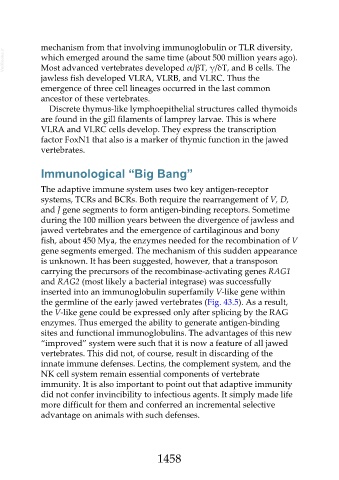Page 1458 - Veterinary Immunology, 10th Edition
P. 1458
mechanism from that involving immunoglobulin or TLR diversity,
VetBooks.ir which emerged around the same time (about 500 million years ago).
Most advanced vertebrates developed α/βT, γ/δT, and B cells. The
jawless fish developed VLRA, VLRB, and VLRC. Thus the
emergence of three cell lineages occurred in the last common
ancestor of these vertebrates.
Discrete thymus-like lymphoepithelial structures called thymoids
are found in the gill filaments of lamprey larvae. This is where
VLRA and VLRC cells develop. They express the transcription
factor FoxN1 that also is a marker of thymic function in the jawed
vertebrates.
Immunological “Big Bang”
The adaptive immune system uses two key antigen-receptor
systems, TCRs and BCRs. Both require the rearrangement of V, D,
and J gene segments to form antigen-binding receptors. Sometime
during the 100 million years between the divergence of jawless and
jawed vertebrates and the emergence of cartilaginous and bony
fish, about 450 Mya, the enzymes needed for the recombination of V
gene segments emerged. The mechanism of this sudden appearance
is unknown. It has been suggested, however, that a transposon
carrying the precursors of the recombinase-activating genes RAG1
and RAG2 (most likely a bacterial integrase) was successfully
inserted into an immunoglobulin superfamily V-like gene within
the germline of the early jawed vertebrates (Fig. 43.5). As a result,
the V-like gene could be expressed only after splicing by the RAG
enzymes. Thus emerged the ability to generate antigen-binding
sites and functional immunoglobulins. The advantages of this new
“improved” system were such that it is now a feature of all jawed
vertebrates. This did not, of course, result in discarding of the
innate immune defenses. Lectins, the complement system, and the
NK cell system remain essential components of vertebrate
immunity. It is also important to point out that adaptive immunity
did not confer invincibility to infectious agents. It simply made life
more difficult for them and conferred an incremental selective
advantage on animals with such defenses.
1458

